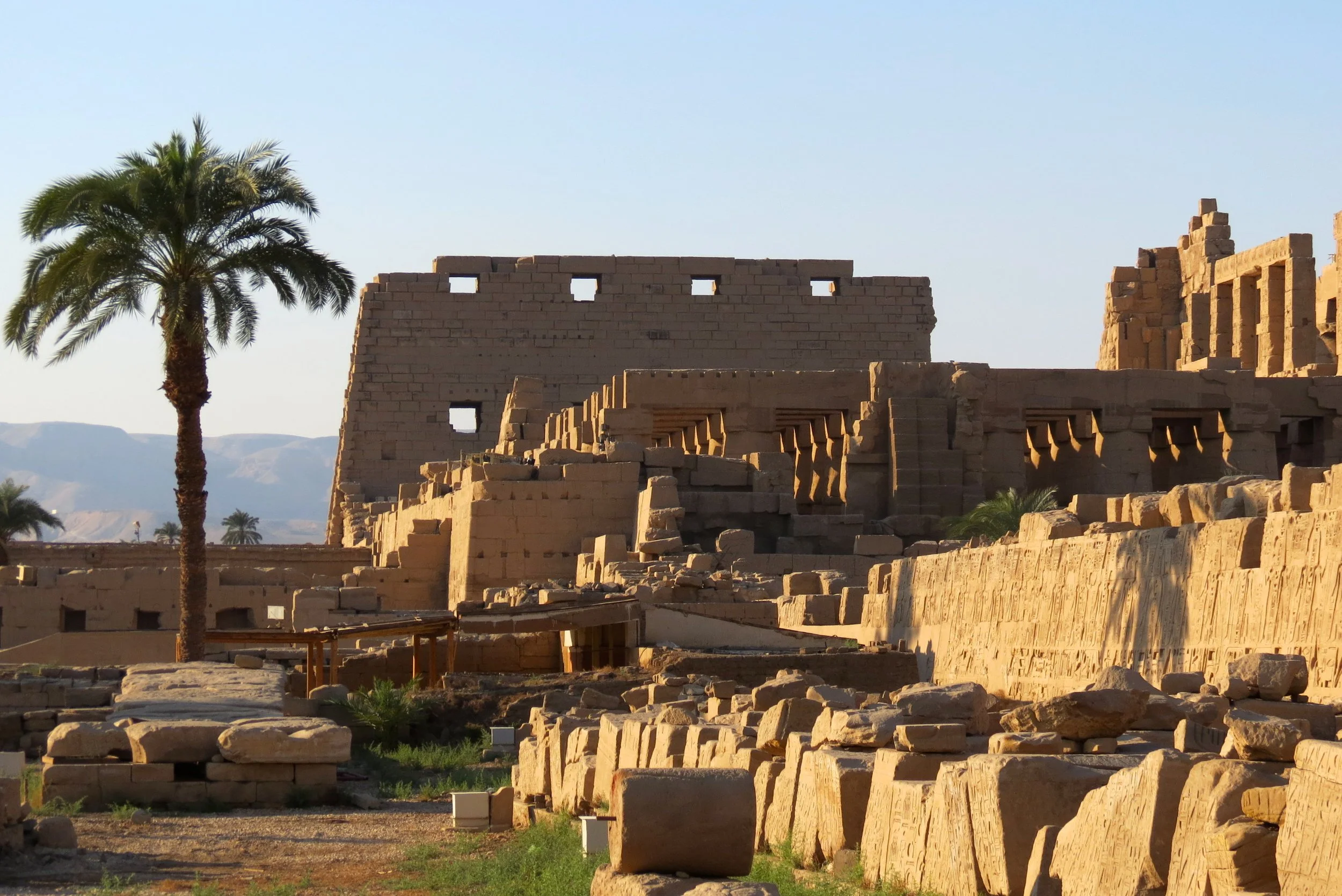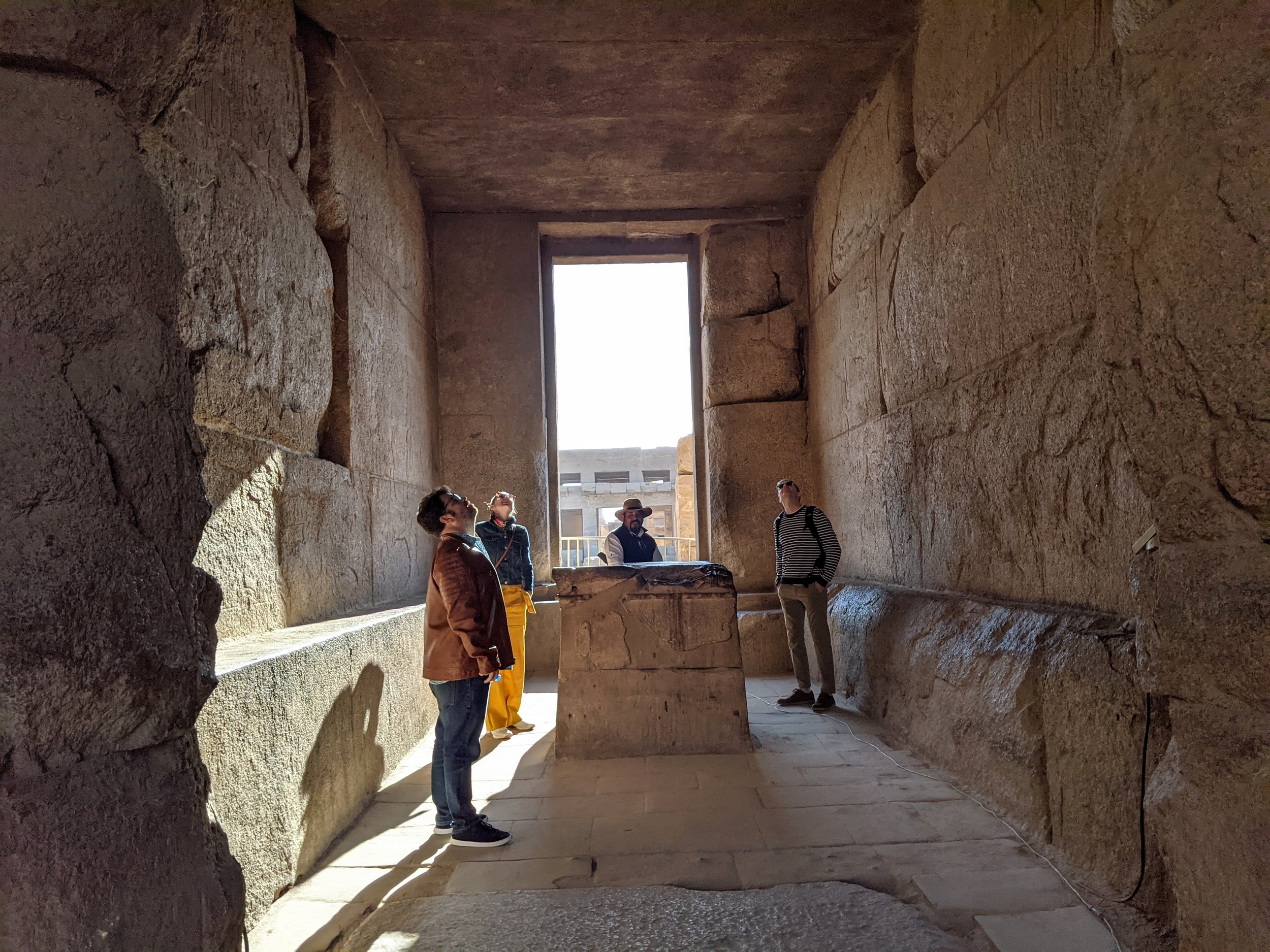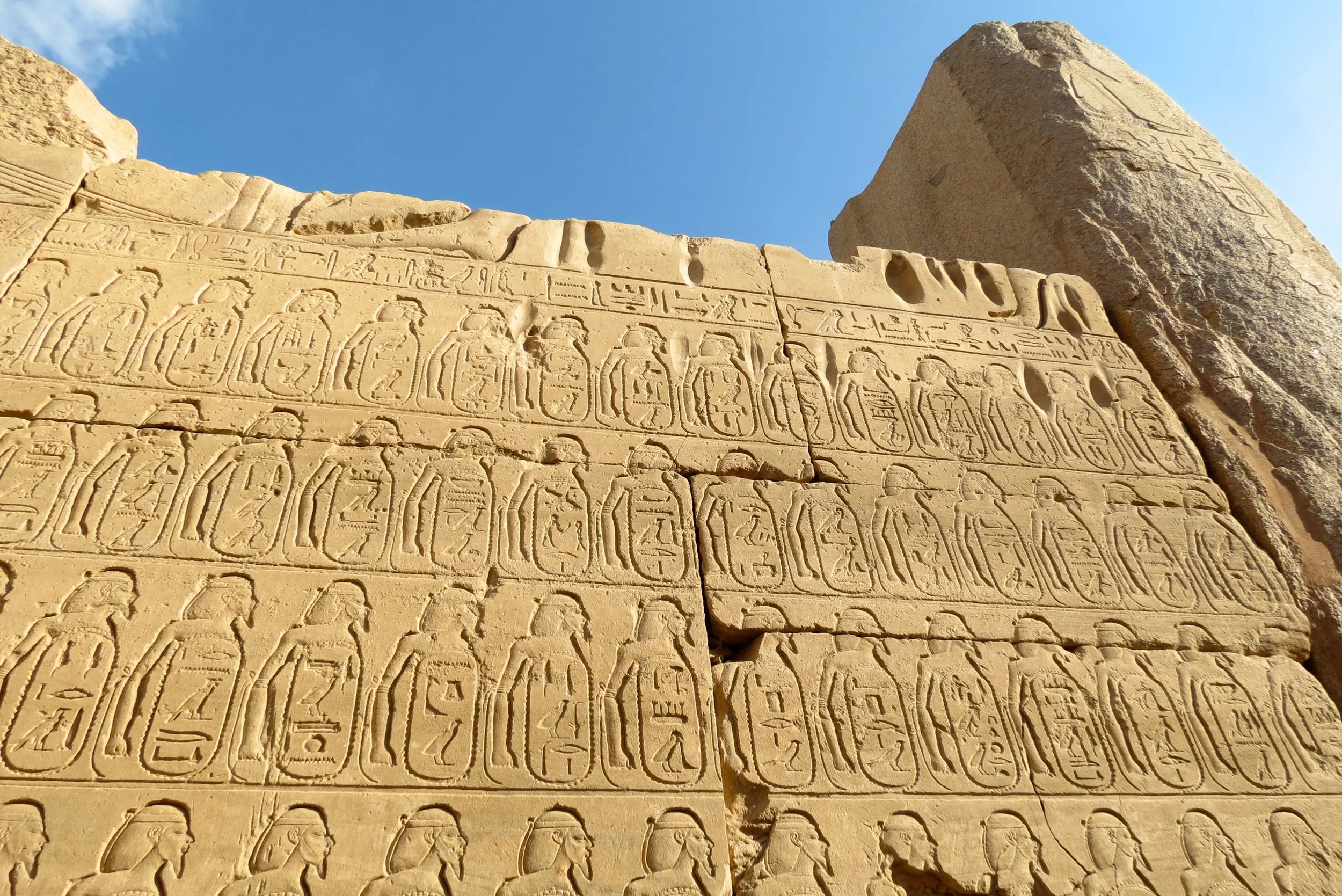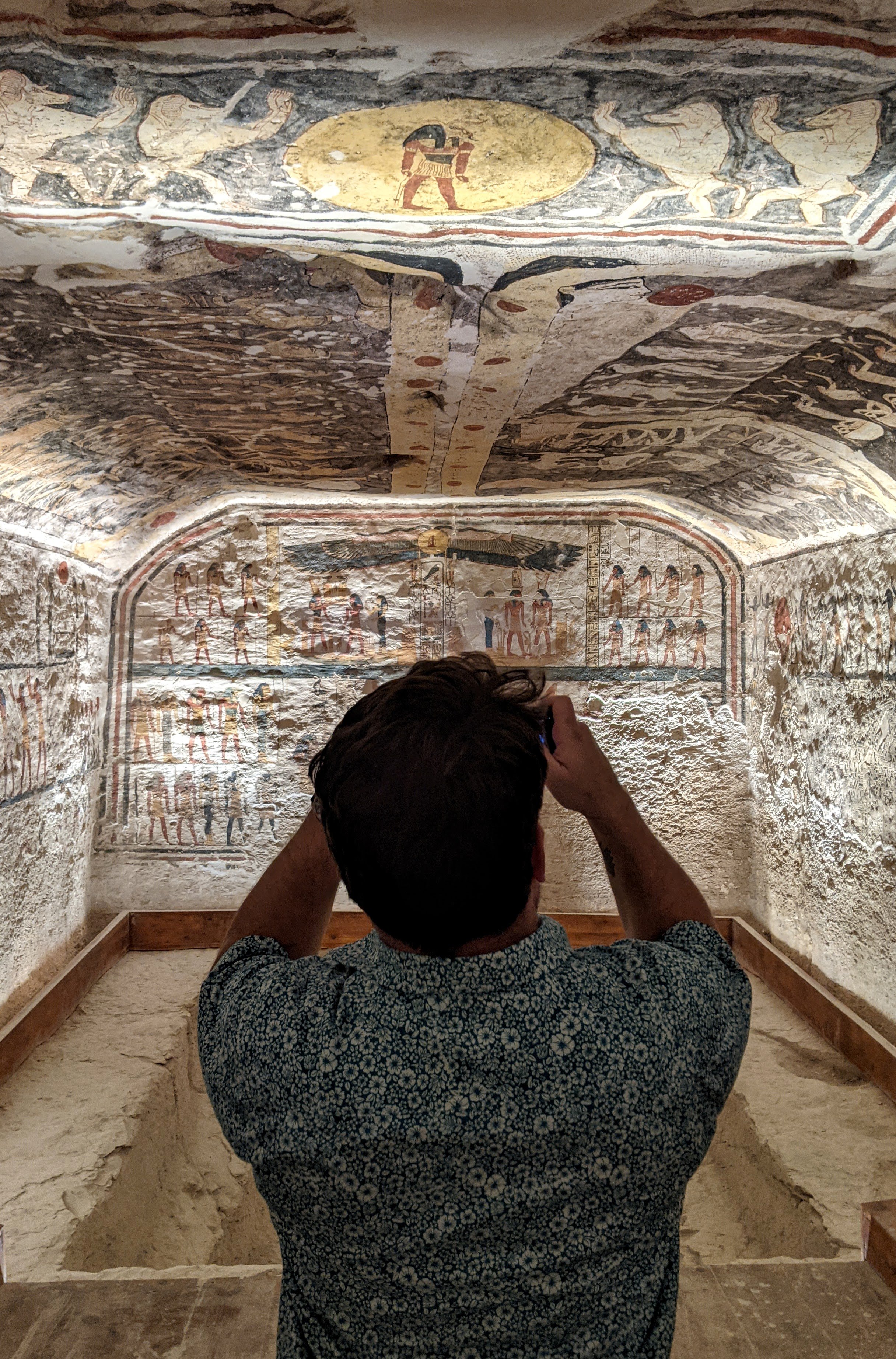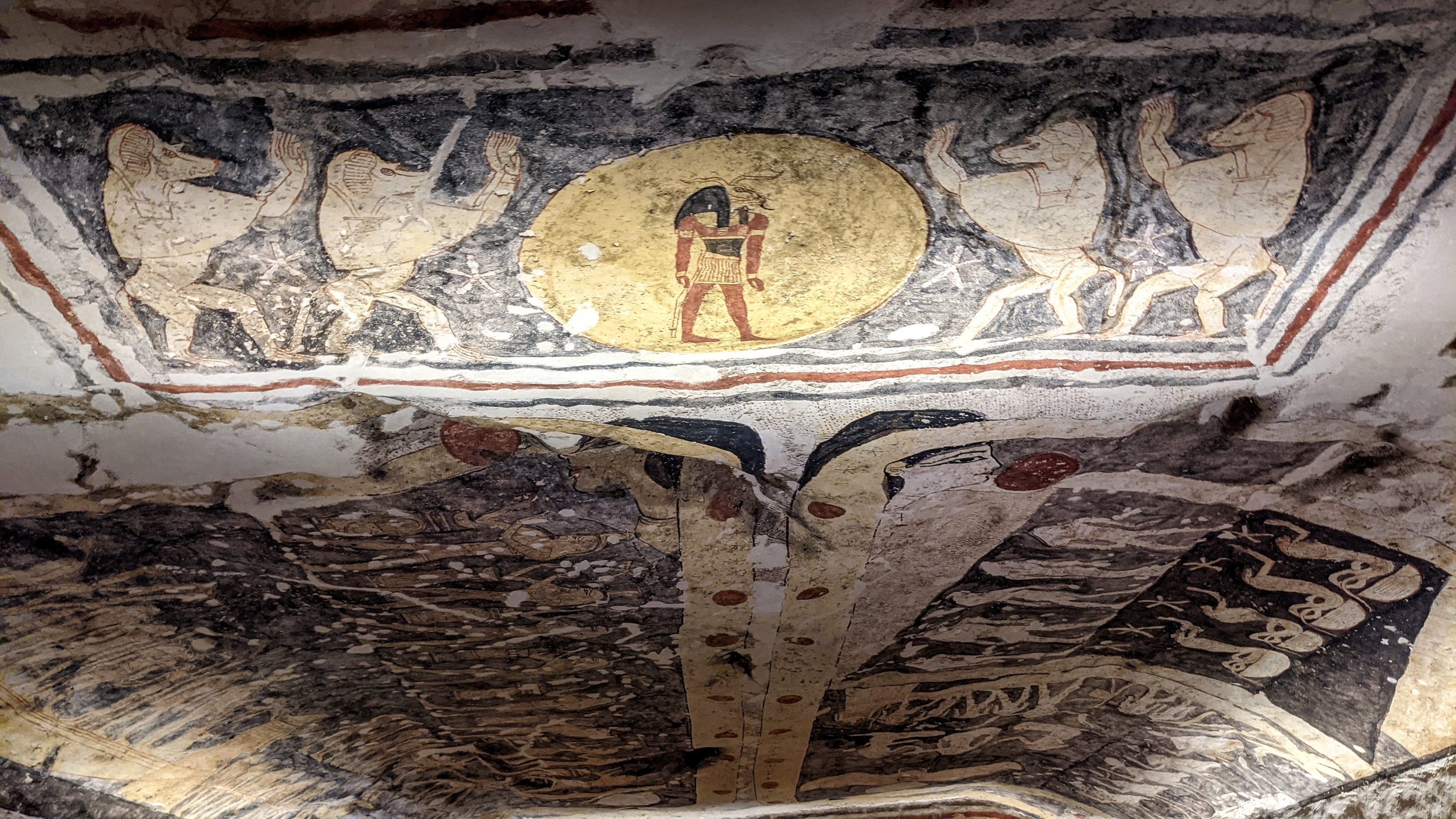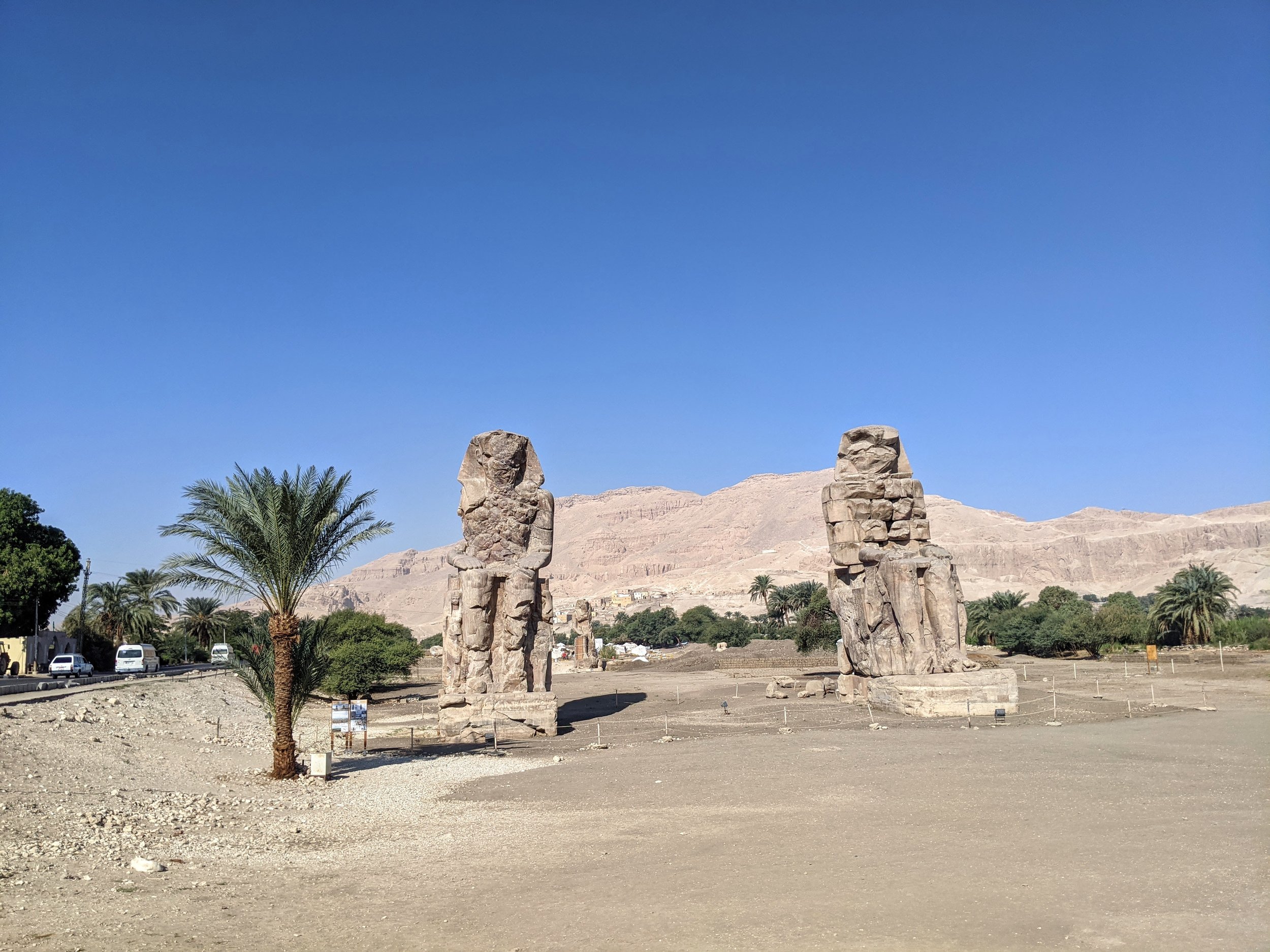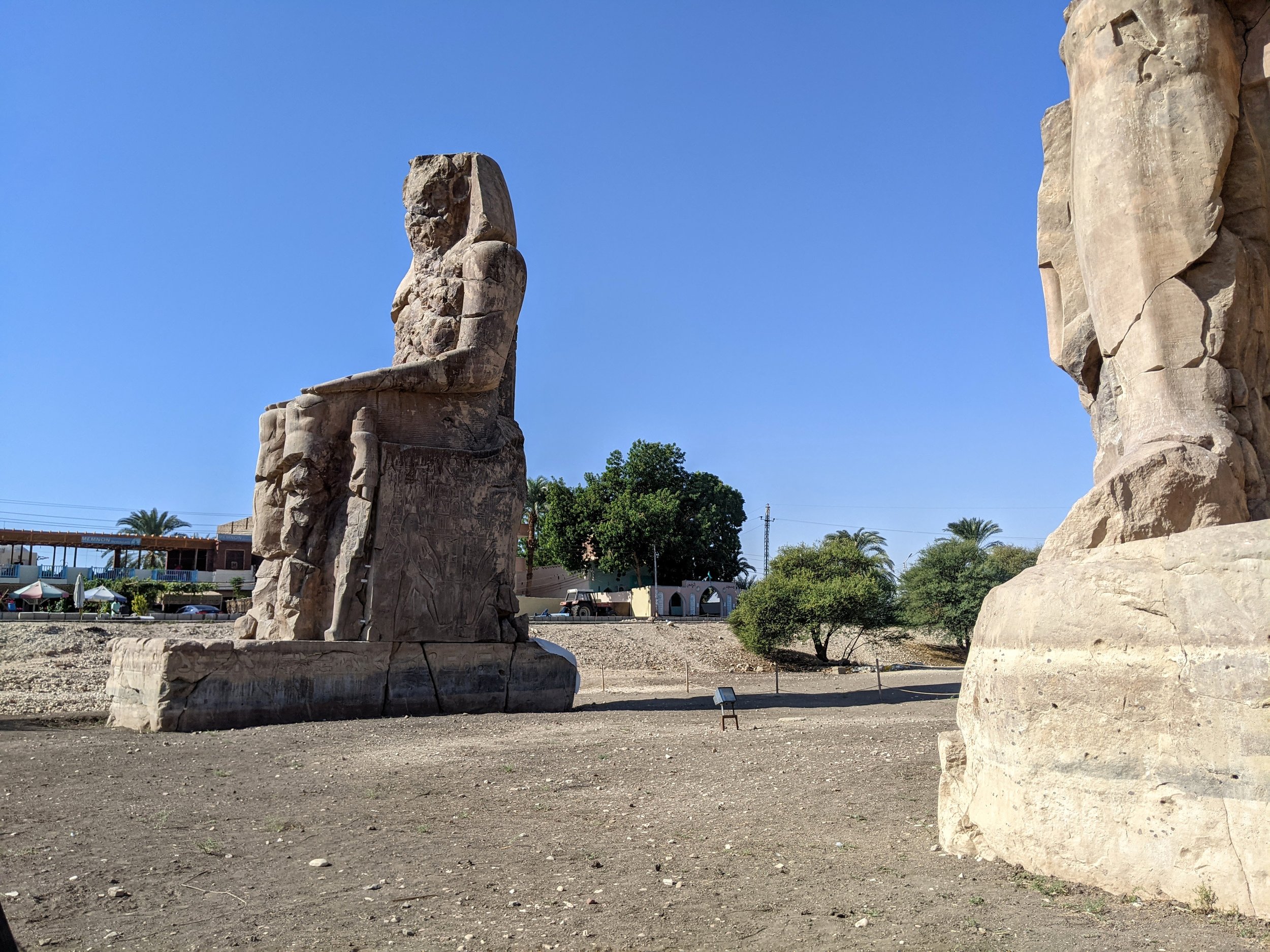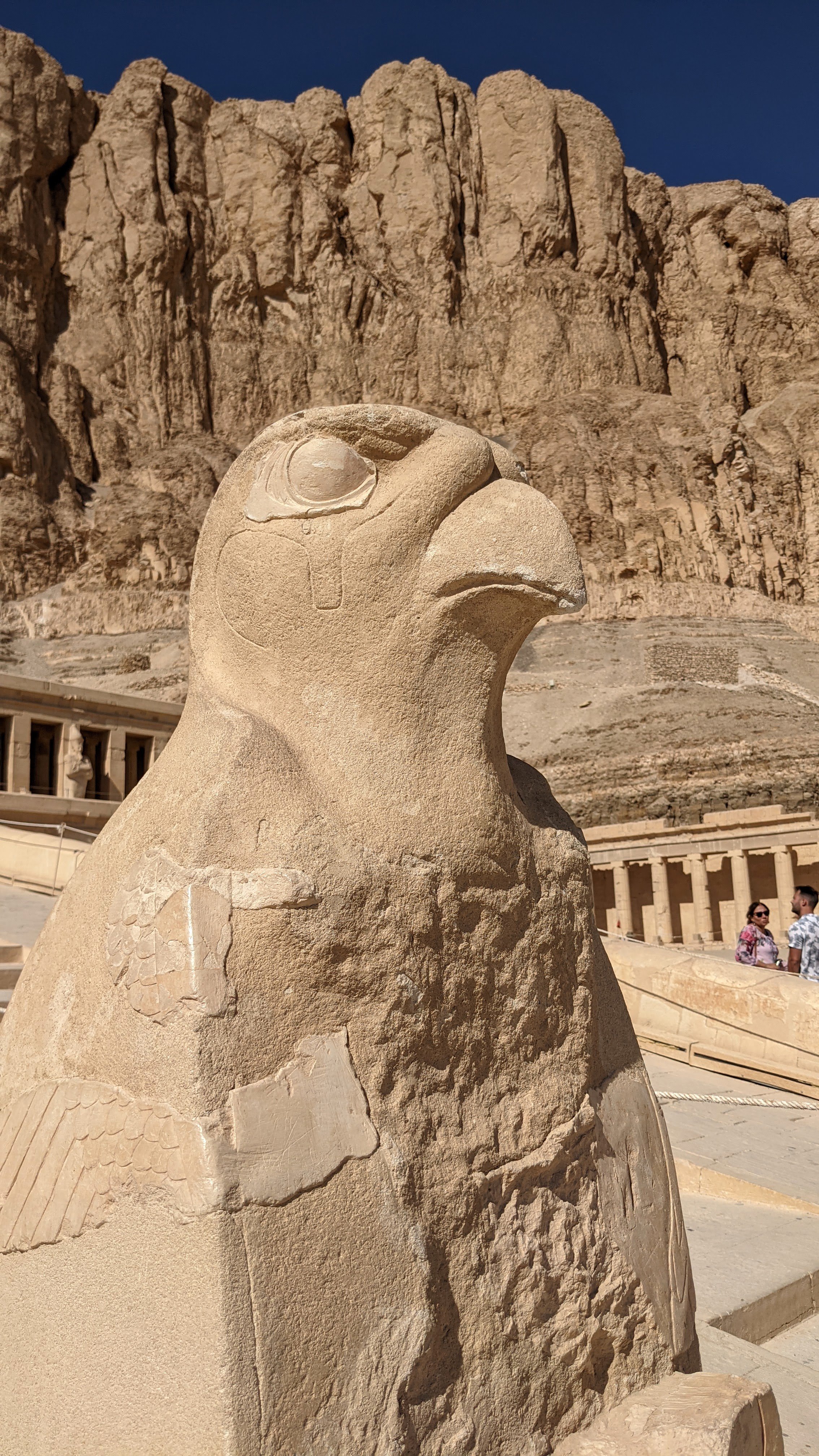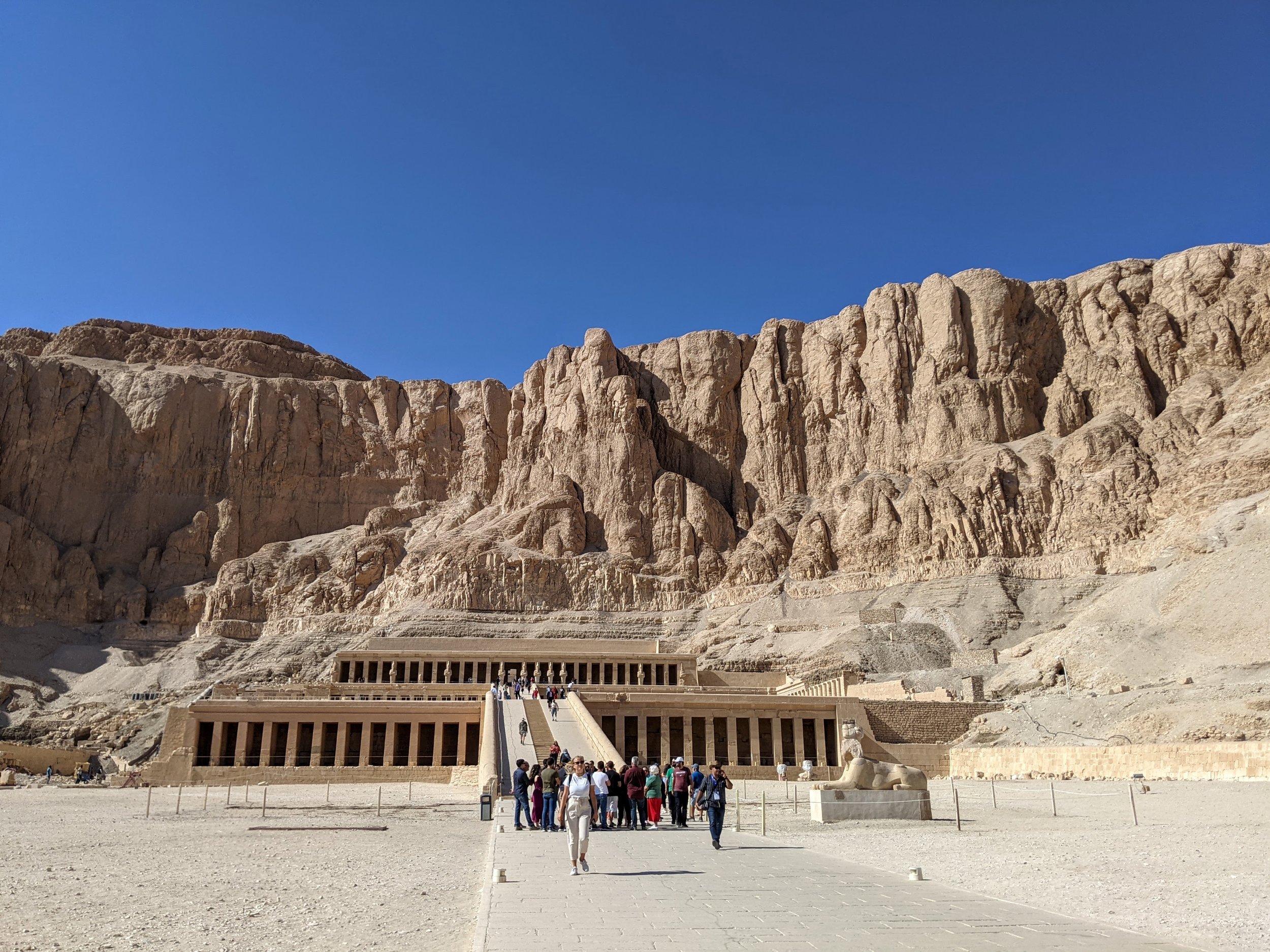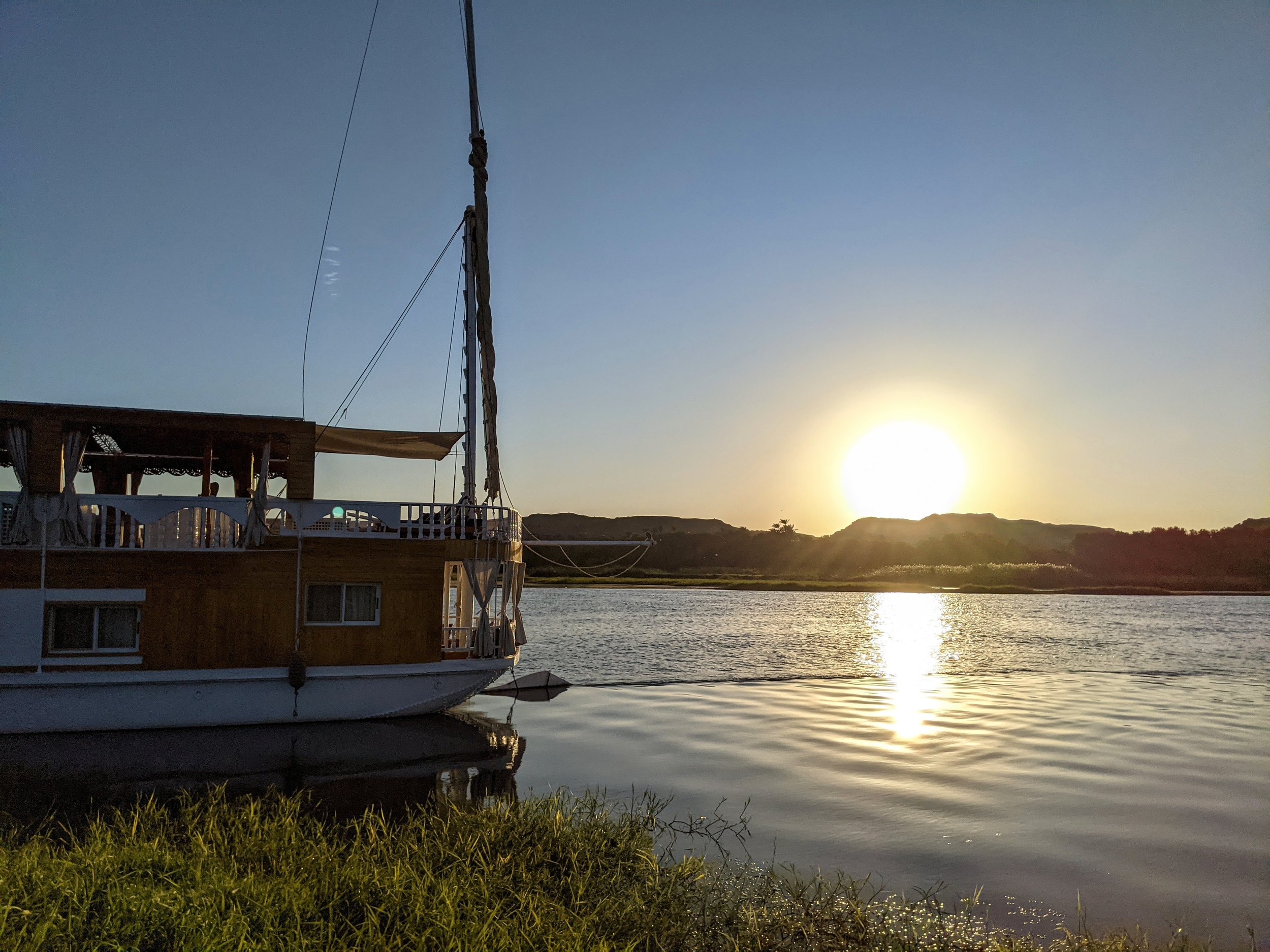lovely luxor
My dear friend,
I’ve confessed to you that I’m an anxious packer, haven’t I? All of those decisions about what to bring and what to leave behind; all of those attempted predictions about who I’ll be or what I’ll want in a week or ten days’ time—sometimes it’s too much to bear!
And yet, with all the traveling we’ve done over the past few months, I’ve gotten a little better at it. So I was surprised to find that in the hour before our departure for Luxor, a new panic rolled over me in waves and I found myself kneeling beside my suitcase in tears.
The pillars at Karnak Temple in Luxor.
Somehow, with C.’s help, I managed to zip up my bag and get out the door. It wasn’t until we were in the Uber with our friends—they’d come all the way from Minneapolis to see us, and since I was determined to show them the best possible time, my panic attack was particularly unwelcome—that I was able to understand and articulate why I was so upset. My body was remembering something my mind had buried: the last time C. and I were in an Uber on the way to Cairo Airport to catch a flight to Luxor, the driver had gotten lost and taken a wrong turn. Suddenly, we’d found ourselves facing the wrong end of a dozen machine guns wielded by a group of teenage soldiers at the end of an unmarked dirt road in the dark. Everything turned out fine, but the flash of fear we’d felt lingered for days. Evidently my memories of lovely Luxor are still interlaced with it.
C. looking out over the parade.
This time, we arrived at the airport without incident. By the time our bags were checked and we’d boarded our flight, my heart had settled slightly. When we landed in Luxor around one a.m., the street outside our hotel was full of lights and drummers and marchers practicing a parade for the president’s visit later that week. Luxor had uncovered and restored the 3000-year-old Avenue of the Sphinxes that had once connected the city’s two major temples, and the result of their decades-long effort was about to be unveiled and celebrated. All four of us were exhausted, and we had to rise again in only a handful of hours, but we spent a few minutes on the darkened rooftop anyway, watching the festive rehearsal below.
Later, curious about the glitzy spectacle, I read that the fancy floats and gauzy dancers and glowing news coverage obscured some unpleasant facts about the project: hundreds of houses had been razed to clear the view around Luxor Temple, and the sphinxes were dug up with bulldozers that damaged the statues and resulted in quick—and often crude—repairs in concrete.
A row of sphinxes in Karnak.
To me, this situation with the sphinxes exemplifies Luxor’s complicated relationship to the history it has inherited. The city’s name likely comes from “El-Uqsur,” an Arabic term meaning “the places” or “the castles”—perhaps because the town of Luxor was built among the visible, crumble ruins of ancient Thebes. The capital of ancient Egypt during much of the Middle and New Kingdoms, Thebes was famous enough to earn a mention in Homer’s Iliad as “Thebes of the Hundred Gates.”
Thebes declined in Roman and Muslim times, although it was never abandoned entirely. During the nineteenth century, after Napoleon’s expedition to Egypt, foreigners grew fascinated by the city’s history and archeology. Europeans launched the first major excavation projects, and over the years the trickle of tourism grew close to a deluge. Luxor is now caught between a responsibility to preserve its treasures and a desire to court tourists in order to capitalize on that steady stream of revenue.
Luxor’s popularity among tourists was the reason why we rose early the morning after our arrival: we wanted to reach the Temple of Karnak before the buses. As we drove through streets much cleaner than Cairo’s, I remembered Karnak as being one of my favorite sites from the first time C. and I visited Luxor six years prior. It’s stunning in the early morning and the late afternoon, as sunlight weaves between the columns and the hieroglyphics glow gold. The temple is so vast, the columns so massive, that a visitor feels extra-small, extra-insignificant. At every turn, we were reminded that we were walking through a house of the gods. Perhaps this is why we spent so much time looking skyward.
The Great Hypostyle Hall, where I lingered longest, is the grandest spot in the temple. At 6000 square meters, my Rough Guide informed me, it could contain both St. Peter’s Cathedral in Rome and St. Paul’s Cathedral in London. It shares with those sacred places an immense and hallowed feeling—and although we were lucky enough to find ourselves alone in the column-forest for a few minutes, I would like to think that it would have moved me even if the crowds had been packed around us.
The Karnak complex was built over a period of 1300 years, beginning in about 2000 BCE. Thirty pharaohs contributed to its construction, which is why it is one of the most massive and most diverse geological sites in Egypt. (Its popularity with tourists is second only to the Pyramids of Giza.) At its height, Karnak’s wealth was extraordinary: during the reign of Ramses III, it encompassed over fifty villages, hundreds of gardens, and thousands of fields cattle. The temple complex was called Ipet-Isut: “the most perfect or esteemed of places.” It was so perfect, in fact, that commoners were not allowed to set foot in the holy spaces.
It’s probably best not to dwell on what the gods thought of us: four commoners who were rumpled and unshowered and dazed by the gathering strength of the sun. If they ask, please assure them that we didn’t stay for long, as Luxor holds many wonders, and we only had a few more hours to see them. So, once we’d wandered back through the columns, we exited through the requisite gift shops—
—where we kept our hands in our pockets (lest vendors drop an item into our arms and then insist that we pay for it) and our expressions stern and discouraging. Then we crossed town to the Valley of the Kings.
Can you see the mummy’s head and upper body resting in the rocks?
The Valley of the Kings in Luxor is the stiflingly hot stretch of desert, stripped of greenery or shade, where pharaohs of the New Kingdom chose to hide their graves and their treasures. These secrets were never well-kept; most of the tombs were robbed not very long after they’d been sealed. Already in 60 B.C., a Greek traveler said of the tombs in this very valley: “We found nothing there except for the results of pillage and destruction.” Previous names for the Valley include “The Great Necropolis of Millions of Years of Pharaoh” and “The Place of Truth.” So far, 63 tombs have been discovered. The most famous in recent memory belonged, of course, to King Tut—whose curse also allegedly struck down several of the major players involved in the excavation.
These days, it is not the tombs that threaten the visitors but the visitors who threaten the tombs. The carbon dioxide that we exhaled and the droplets of sweat that rolled down our skin increased the humidity of the tombs and weakened the stability of the gorgeous plaster-on-limestone paintings. We couldn’t stop breathing and we definitely couldn’t stop sweating, and we didn’t mean to be damaging the ancient art—but certainly, we were. Perhaps our destruction wasn’t totally analogous to using bulldozers to dig up sphinxes—but it wasn’t unrelated, either.
We’re always on the lookout for images of Anubis.
To combat the effects of mass tourism, the Department of Antiquities has established a system whereby only ten tombs are open at one time (they’re on a rotation schedule) and each visitor’s ticket allows entry into only three tombs. But a grander plan to encourage more sustainable tourism is already in the works: Egypt hopes to create life-size replicas of many of the royal tombs so that visitors can experience their magnificence without threatening their survival. Already King Tut’s replica is up and running, thanks to a machine-carved facsimile. “What the site lacks in aura, it may make up for in context,” suggests The Guardian. As Adam Lowe, the British artist and restorer who led the project, has argued: “This is not about taking things away. It’s about bringing things back.”
If the plan is realized, according to my Rough Guide, it is likely that “access to the Valley of the Kings will be restricted to a few premium-paying visitors, and ordinary tourists obliged to settle for replica tombs.” This late-capitalist move feels a little like a return to the Thebes of yore, when only the rich and powerful were permitted to experience these marvelous, holy spaces.
Yet one certainly understands the instinct to protect the city’s historical wealth. Even now, there are moments when Luxor feels less like an archeological wonder than like a Disney World interpretation of an archeological wonder: the gift shops, the miniature trains, the Plexiglass, the chilled glasses of lemon-and-mint juice. The grand Colossi of Memnon, once standing guard to the grandest mortuary temple in the necropolis, are now a roadside attraction. Buses and taxis and vans pull to the shoulder of the highway so that tourists can hop out, snap a photo, and hop back in.
Somewhere along the way, the colossi lost their faces and their crowns. I rather like this about them, though.
Indeed, as we wrapped up our tour of Luxor at the Temple of Hatshepsut, commissioned by one of ancient Egypt’s rare but powerful female rulers, I found myself most intrigued by the parts of the structure that had been effaced. After Hatshepsut’s death, her nephew tried to diminish her historical stature by erasing her face and the cartouches with her name from her monuments, thus demoting her from pharaoh to regent and making it seem as though the dynasty had been one long uninterrupted male line. Later, the pharaoh Akhenaten tried to remove all references to the god Amun, since he was launching a new cult devoted solely to the sun god. Even later, when the space was turned into an early Christian monastery, the monks did their best to erase remaining pagan iconography.
As we wound our way down to the Nile and to the boat that awaited us there, I tried to imagine a gleaming new museum full of tomb replicas that had rolled straight out of 3-D printers. I thought about the impossibility of preserving something, anything, unchanged across time.
Though sometimes I may wish that I had only positive associations with Luxor, and that I could somehow chisel away the lingering fear that shaped my first visit to the city, the best I can do is layer a new memory on top it, expanding the range and scale of my associations as a pharaoh might (forgive me!) expand the range and scale of Karnak.
If a museum ever decides to print out a 3-D replica of me, tell them not to leave anything out.
Yours—
L.

